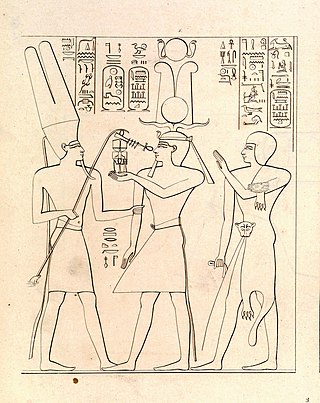Related Research Articles

The three-age system is the periodization of human prehistory into three time-periods: the Stone Age, the Bronze Age, and the Iron Age, although the concept may also refer to other tripartite divisions of historic time periods. In some periodizations, a fourth Copper Age is added as between the Stone Age and Bronze Age. The Copper, Bronze, and Iron Ages are also known collectively as the Metal Ages.

Egyptology is the scientific study of ancient Egypt. The topics studied include ancient Egyptian history, language, literature, religion, architecture and art from the 5th millennium BC until the end of its native religious practices in the 4th century AD.
Below are notable events in archaeology that occurred in 1952.

A Venus figurine is any Upper Palaeolithic statue portraying a woman, usually carved in the round. Most have been unearthed in Europe, but others have been found as far away as Siberia and distributed across much of Eurasia.
James Henry Breasted was an American archaeologist, Egyptologist, and historian. After completing his PhD at the University of Berlin in 1894 – the first American to obtain a doctorate in Egyptology – he joined the faculty of the University of Chicago. In 1901 he became director of the Haskell Oriental Museum at the university, where he continued to concentrate on Egypt. In 1905 Breasted was promoted to full professor, and held the first chair in Egyptology and Oriental History in the United States.

Archibald Henry SayceFRAS was a pioneer British Assyriologist and linguist, who held a chair as Professor of Assyriology at the University of Oxford from 1891 to 1919. He was able to write in at least twenty ancient and modern languages, and was known for his emphasis on the importance of archaeological and monumental evidence in linguistic research. He was a contributor to articles in the 9th, 10th and 11th editions of the Encyclopædia Britannica.
Archaeology is the study of human activity in the past, primarily through the recovery and analysis of the material culture and environmental data that they have left behind, which includes artifacts, architecture, biofacts and cultural landscapes.

Dorothy Annie Elizabeth Garrod, CBE, FBA was an English archaeologist who specialised in the Palaeolithic period. She held the position of Disney Professor of Archaeology at the University of Cambridge from 1939 to 1952, and was the first woman to hold a chair at either Oxford or Cambridge.

The Palestine Exploration Fund is a British society based in London. It was founded in 1865, shortly after the completion of the Ordnance Survey of Jerusalem by Royal Engineers of the War Department. The Fund is the oldest known organization in the world created specifically for the study of the Levant region, also known as Palestine. Often simply known as the PEF, its initial objective was to carry out surveys of the topography and ethnography of Ottoman Palestine – producing the PEF Survey of Palestine. Its remit was considered to fall between an expeditionary survey and military intelligence gathering. There was also strong religious interest from Christians; William Thomson, Archbishop of York, was the first president of the PEF.
The Gerzeh culture, also called Naqada II, refers to the archaeological stage at Gerzeh, a prehistoric Egyptian cemetery located along the west bank of the Nile. The necropolis is named after el-Girzeh, the nearby contemporary town in Egypt. Gerzeh is situated only several miles due east of the oasis of Faiyum.
Below are notable events in archaeology that occurred in 1881.
Below are notable events in archaeology that occurred in 1935.

Gertrude Caton Thompson was an English archaeologist at a time when participation by women in the discipline was uncommon. Much of her archaeological work was conducted in Egypt. However, she also worked on expeditions in Zimbabwe, Malta, and South Arabia.

The Land of Punt (Egyptian: pwnt; alternate Egyptological readings Pwene(t) ) was an ancient kingdom known from Ancient Egyptian trade records. It produced and exported gold, aromatic resins, blackwood, ebony, ivory and wild animals. Recent evidence locates it in northwestern Eritrea. It is possible that it includes or corresponds to Opone, as later known by the ancient Greeks, while some biblical scholars have identified it with the biblical land of Put or Havilah.

The Bible makes reference to various pharaohs of Egypt. These include unnamed pharaohs in events described in the Torah, as well as several later named pharaohs, some of whom were historical or can be identified with historical pharaohs.

The Neolithic period in the British Isles lasted from c. 4100 to c. 2,500 BC. Constituting the final stage of the Stone Age in the region, it was preceded by the Mesolithic and followed by the Bronze Age.

John Henry Middleton was an archaeologist and a museum director.
Robin W. Dennell is a British prehistoric archaeologist specialising in early hominin expansions out of Africa and the Palaeolithic of Pakistan and China. He is Professor Emeritus of Human Origins of the University of Sheffield, and an honorary professor at the University of Exeter.
References
- ↑ "Palaeolithic, adj. and n.". Oxford English Dictionary online version (3rd ed.). Oxford University Press. December 2011. Archived from the original on 2012-02-26. Retrieved 2012-02-24.(subscription or participating institution membership required)
- ↑ "The History of the PEF". pef.org.uk. Retrieved 18 May 2017.
- ↑ "James Henry Breasted". britannica.com. Retrieved 31 May 2017.
- ↑ "Foucher, A. (Alfred) 1865-1952". worldcat.org. Retrieved 2 June 2017.
- ↑ Edwards, Edward (17 June 2010). Lives of the Founders of the British Museum: With Notices of Its Chief Augmentors and Other Benefactors, 1570-1870. Cambridge University Press. p. 43. ISBN 9781108014953.